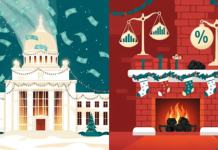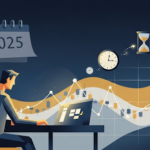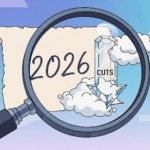It seems even an inverted yield curve can’t dampen the market’s spirits! While some investors sulk in the corner (we’re looking at you, Big Bears), others are dancing to the tune of opportunity. But who’s really pulling the strings in this economic symphony? Is it the Fed? The elusive “IULO” investors? Maybe even that mysterious Open Market Desk?
Today’s main story unravels the mystery behind who benefits from a resilient market (hint: it’s not who you think). We’ll explore how the Fed’s balancing act is shaping the investment landscape and what it means for your portfolio.
Plus, get ready to expand your financial IQ with our “This Week I Learned” section. Discover surprising market insights and practical tips to stay ahead of the curve. And because we believe in a little fun with our finance, we’ve sprinkled in some intriguing market trivia that might just make you the star of your next cocktail party. (No cocktail party? Just pretend. We won’t tell.)
So, settle in and get ready to discover how the market’s resilience might just be your next big opportunity. Let’s dive in!
This Week I Learned…
The Fed’s Unexpected Market Role: Guardian, Not Destroyer
This week, we learned that the Federal Reserve isn’t just about raising and lowering interest rates. Turns out, they’re playing a much bigger game – one where they’re actually protecting the market from a crash. Surprising, right?
You might think the Fed’s actions, like their new forecasting model, are designed to rain on everyone’s parade. But in reality, they’re more like a vigilant gardener, carefully pruning the yield curve to ensure healthy growth (and a bountiful harvest for investors). They’re preventing those with the deepest pockets from hoarding all the risk-free bonds and leaving the rest of us with scraps.
So, the next time you hear whispers of a market crash, remember this: the Fed might just be the unsung hero, working behind the scenes to keep the economy humming along.
Key Takeaway: The Federal Reserve’s policies, though complex, are ultimately aimed at maintaining market stability. Understanding their role can help you make more informed investment decisions and feel more confident about the future of your portfolio.
The Fun Corner
Why Did the Bond Trader Cross the Yield Curve?
To get to the other side…of the trade! (Ba-dum-tss!)
Okay, okay, we know that wasn’t our best work. But in all seriousness, the yield curve has been quite the headliner lately. It’s been flipping and flopping more than a pancake on a hot griddle! But hey, that’s the market for you – always keeping us on our toes.
Speaking of toes, did you hear about the investor who got cold feet? He thought he was buying low and selling high, but he was buying high and selling his couch because he needed the cash!
Alright, we’ll stop now. But remember, laughter is the best medicine, especially in the sometimes stressful world of investing. So next time the market throws you a curveball (or a yield curve inversion), just take a deep breath and remember: it’s all part of the fun!
Fed’s Market Moves: Friend or Foe?
The S&P 500 Index has been surprisingly resilient despite a slowing economy and a stubbornly inverted Treasury Yield Curve (TYC). This “Goldilocks” scenario of moderate growth, inflation, and interest rates has been a boon for many investors. Yet, tensions simmer beneath the surface.
While some individual investors (“Big Bears”) grumble about a seemingly endless bull market rally, institutional players like pension funds and insurance companies are openly pessimistic. Their concern? The inverted yield curve, which historically signals a recession, and the Fed’s recent moves have curtailed their risk-free bond haven.
The Bond Bonanza Ends, But New Opportunities Emerge
Institutional investors, with their vast capital, have enjoyed a windfall in the bond market during the turbulent 2020-23 period. However, the inverted TYC is throwing a wrench in their plans. Rolling over maturing bonds means locking in lower yields, and the Fed’s new forecasting model, designed to optimize the yield curve, inadvertently limits their long-term bond investment options.
But where one door closes, another opens. The current market conditions present a unique opportunity for individual “uptrend-and-long-only” (IULO) investors, known for their disciplined approach and long-term perspective. As institutional investors exit the bond market, IULO investors are poised to capitalize on the shifting landscape.
Understanding the Yield Curve: A Two-Sided Story
The TYC is a complex beast, reflecting both economic growth (positive side) and inflation/interest rates (negative side). The Fed, global bond investors, and the New York Fed’s Open Market Desk all play a role in shaping its contours.
The Fed recently showcased its ability to swiftly stabilize the yield curve, a testament to the flexibility of the U.S. market and the importance of an independent central bank. This move further highlights the Fed’s role as a market protector rather than a destroyer.
The Road Ahead
The market has been a mixed bag lately, with the S&P 500 experiencing both gains and losses. While upcoming data, such as the May Nonfarm Payrolls Report, will provide more clarity, a cautious optimism prevails for this election year.
The overarching question remains: Is the Fed a friend or foe to investors? As the bond market shifts and new opportunities arise, the Fed is clearly playing a more nuanced role than many realize. Their actions, while sometimes puzzling, are ultimately aimed at maintaining market stability and creating a level playing field for all investors.
The Last Say
The Market’s Unexpected Guardian
As we wrap up this week’s edition of The Market Pulse, one thing is clear: the financial landscape is constantly shifting. While some investors see storm clouds on the horizon, others are finding sunshine in the form of new opportunities.
The Federal Reserve, often viewed as a market antagonist, is proving to be a surprising ally. Their actions, though sometimes complex and even counterintuitive, are ultimately aimed at maintaining stability and protecting the market from a major downturn.
As institutional investors recalibrate their strategies and individual investors step up to the plate, the market is evolving. It’s a reminder that even in the face of uncertainty, there are always chances to learn, grow, and thrive.
So, keep your eyes peeled and your mind open. The market’s resilience might just be your next big win.

























